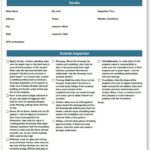Ultimate Guide to Home Inspection Checklists [+Templates]
When you are buying a new or previously owned home, one of the final steps in the home buying process is to have a qualified home inspector perform a home inspection.
These inspections are designed to help potential buyers identify any problems that they would consider to be a deal-breaker. If there’s an inspection contingency in place, homebuyers can walk away from a real estate purchase if a problem is found during the inspection.
An important part of the process for home inspectors is to use a home inspection checklist to help them standardize the data collected and to accelerate the inspection process.
Inspection apps have grown in popularity because they allow the inspectors to capture data and generate reports that help to streamline the home inspection process. Continue reading to learn about the home inspection process, what’s included in a home inspection report, and how you can start to automate the processes for home inspection reports.
What is a home inspection?
The American Society of Home Inspectors defines a home inspection as a visual examination and assessment of the house’s physical structure and systems. Home inspections cover everything from the foundation in the basement to the shingles on the roof.
Home inspections are designed to protect home buyers by ensuring that the home they are purchasing meets their expectations. Inspections also help verify that homeowners’ disclosure statements in the real estate contract are accurate.
The inspection process must be performed by a professional home inspector. After the inspection is complete, homeowners selling their property may have the opportunity to correct certain problem areas. Homeowners may also reduce the sale price so the buyer can address problem areas themselves or the buyer can have the option to walk away from the contract.
Lenders also rely on home inspections to protect their interests. In many cases, lenders will require a home to pass a professional home inspection before loaning money for buyers to purchase the home.
What do home inspectors do?
For average-sized homes in reasonable condition, home inspectors spend between two and four hours checking the state of the following items:
- Heating and central air conditioning systems (HVAC) and ductwork
- Interior plumbing systems and water heaters
- Electrical systems including electrical outlets, electrical panels, and light switches
- The roof, including shingles, flashing, vents, etc.
- Attics and visible insulation
- Walls, ceilings, floors, windows, and doors
- Kitchen and bathroom fixtures and appliances such as faucets, toilets, countertops, garbage disposals, and exhaust fans
- The foundation, typically looking for cracks in the foundation, leaks, or water damage
- The basement area, typically looking for standing water or rotted wood
- Crawl spaces and storage areas
- Structural components
- Chimneys and flues
- Exterior components like downspouts, window exteriors, gutters, patios/decks, facades, stucco, landscaping, etc.
- Septic tanks and sewer system connections
Home inspections are critical to ensuring a home buyer acquires a house that is in good condition. These inspections are vital for older homes that may have potential problems such as asbestos, older plumbing, frayed wiring, damaged systems, and more.
Real estate agents should refer clients to certified home inspectors who have passed the National Home Inspector Exam and have current and up-to-date state licensing. Home inspectors who are ASHI members (the American Society of Home Inspectors) or InterNACHI members (the International Association of Certified Home Inspectors) are often safe choices. Members of these professional organizations have access to excellent training and can obtain advanced certifications through those organizations.
What is in a home inspection report?
Home inspection reports are detailed documents that cover general information about a home. This includes information about:
- The house’s exterior and interior
- Checks of all major systems
- Sewer checks
- Radon testing results
- Whether or not asbestos is present
- Signs of termites
A professional home inspection report has a combination of checklists, images, recommendations, and descriptive text discussing why inspectors may not have inspected certain items.
For example, InterNACHI and ASHI guidelines do not call for the testing of smoke or carbon monoxide detectors, so home buyers are directed to having these devices properly tested or purchased for a home.
Reports typically have a summary at the front that highlights any significant issues. The report then goes into greater detail in each section by highlighting specific problems, recommendations, and potential fixes.
Home inspectors should include some key information on a report like:
- Their name and the company they work for
- License numbers and contact information
- A report ID or report number
A home inspection report should also include some general information like:
- Client & Site Information: Key information includes the inspection date, the address of the inspection, whether anybody is occupying the home, and whether anyone was present at the time of inspection
- Building Characteristics: These characteristics include the building’s age and what type of home it is (e.g., detached single-family, townhome, etc.)
- Climatic or Environmental Conditions: The weather and other conditions such as temperature can impact the outcome of the report
- Utility Service Information: This information includes the water source (public/city or well), sewage disposal (septic or city sewer)
- Payment Information: Knowing who paid for an inspection can be vital in settling disputes later
Inspection reports should also have a key or legend that explains what acronyms mean. For example:
- SER means “Appears Serviceable”
- MM means “Marginal/Maintenance”
- RR means “Replace or Repair”
- SAF means an item is a “Safety Concern”
- NI means an item was not inspected
Automating home inspection reports
Home inspections are labor-intensive, requiring an inspector to visit a home to review all the inspection components thoroughly.
Home inspectors arrive at a home with a clipboard, inspection forms, and a digital camera to photograph different property elements and identify where there are problems. After several hours on-site, the real work begins. Inspectors return to their office to compile the information, associate images with specific report items, and assemble the forms into a cohesive report that can be dozens of pages in length, if not longer.
But mobile apps for home inspections can help to streamline this process for inspectors. A well-designed home inspection checklist app can significantly improve the home inspection process. Companies have started using mobile apps so that inspectors can deliver a completed home inspection report to clients or homebuyers in a matter of minutes after completing the home inspection process.
Digital inspection forms eliminate paper processes and rely on mobile device capabilities to collect data for the report. Here are some of the key features in a home inspection mobile app:
- Create a scalable inspection with countless items included as new line items are added to various rooms or areas.
- Associate any images that the inspector took with the mobile device that the home inspection checklist app is on with the actual line items they refer to.
- Leverage native features of mobile devices such as GPS to verify the location of a home inspection.
- Use conditional logic within the app to create a customized inspection that prompts users to fill out certain information if needed (e.g., checking that there is no basement can remove pages that have inspection items related to the basement).
- Leverage voice-to-text capabilities on a mobile device to rapidly generate longer descriptions of inspection items and provide more valuable information to clients.
Home inspectors that use these apps can deliver a completed home inspection report to clients or homebuyers in a matter of minutes after completing the home inspection. They can immediately send the inspection report as a PDF that includes all the images taken, descriptions of problem areas, and detailed information about all home inspection checklist items.
Companies embracing this technology will see a boost in their productivity, as inspectors will be able to produce more inspections each day because they are spending less time preparing reports. Mobile apps can also help companies reduce errors. Since the report is being generated in real-time, inspectors do not have to go back later to match content after the inspection or recreate details based on potentially incomplete notes.
Mobile apps are a great solution for companies looking to modernize the home inspection process with technology that is designed to streamline processes, reduce errors, and eliminate time-consuming work for inspectors.
Why You Should Consider GoCanvas for Home Inspection Checklists
Paper forms become difficult to manage for home inspectors and home builders in the construction industry. A leading residential inspection company, US Inspect, found that their paper-intensive processes hindered their efficiency.
Before finding GoCanvas, US Inspect managed all information through Excel spreadsheets and email. These processes hindered the company’s growth and sparked their search for a data collection solution. As the company grew, JB Haller, CEO at US Inspect, realized that they needed a solution to give them a more efficient way to organize and analyze their data.

GoCanvas helps companies like US Inspect to streamline their home inspections by eliminating paperwork and automatically generating digital reports. When deploying GoCanvas for home inspections, US Inspect was able to see an immediate return on their investment into the platform. Here are some of the results in action:
- Recovered +9,900 Hours of Productivity Annually
- Over 53,000 Digital Reports Produced Annually
- Annual Dollar Savings of Over $720,000+
Read the US Inspect customer story here to learn more about their experience using GoCanvas for home inspection checklists.
Get Started for Free with Home Inspection Checklists
Ready to see how mobile home inspections work? Check out the GoCanvas home inspection checklist template that can be customized to fit your business needs. This home inspection template is designed to be completed on a mobile device or tablet by inspectors in the field. This template is very comprehensive for home inspectors, covering all aspects of a home to cover during real estate closings.
Home Inspection Checklist Template

- Leverage the dispatch feature to send the right person out for the job
- Simplify the process for collecting data
- Automatically generate PDF reports to share with key stakeholders
- Use the digital signatures feature to get sign-off on documents

Stay in Touch!
About GoCanvas
GoCanvas® is on a mission to simplify inspections and maximize compliance. Our intuitive platform takes care of the administrative tasks, freeing our customers to focus on what truly matters – safeguarding their people, protecting their equipment, and delivering exceptional quality to their customers.
Since 2008, thousands of companies have chosen GoCanvas as their go-to partner for seamless field operations.

Check out even more resources

Improving Your Operations with Field Service Management Software
Whether you have two or 200 employees, your business’ success depends on their hard work. Passionate, motivated team players are the difference between…

Should You Connect Field Service Management Software with QuickBooks?
Field service management software has shown to increase productivity both for employees in the field and operations teams in the office. You may be wondering how field service…

How the Best Field Services Businesses Use Mobile Apps
Mobility and field service: the talk has been happening forever. The idea that real-time information improves customer service and boosts technician productivity is changing…